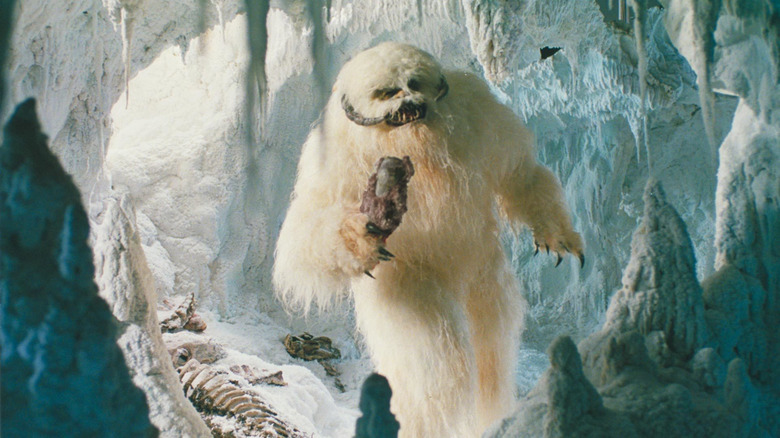The Wampa's Drool In Star Wars: The Empire Strikes Back Was Surprisingly Edible
At the beginning of Irvin Kershner's 1980 sci-fi flick "Star Wars: The Empire Strikes Back," Luke Skywalker (Mark Hamill) is attacked by vicious yeti while patrolling the frozen wastelands of the planet Hoth. The yeti, called a wampa, carries Luke back to its lair, where it feasts on the bones of some other mysterious prey. Luke's feet are frozen to the ceiling, and he remains injured and dangling, unable to defend himself. Luckily, Luke brought a lightsaber with him, and he's able to use it to free himself and slay the yeti. It's a pity that the makers of "The Empire Strikes Back" didn't think to include a scene wherein the space yeti fought Chewbacca, a space sasquatch.
In the original (and now unavailable) cuts of "Empire Strikes Back," the wampa was barely seen, achieved only through a clumsy costume and clever editing that left the bulk of its massive body obscured. On the 1998 CD-ROM documentary "Star Wars: Behind the Magic," it was revealed that a wampa was originally meant to swim through the snow like a fish through water. There was also a deleted scene wherein wampas invaded a Rebel base and caused havoc.
Notably, the wampa drooled excessively, perhaps because tauntaun meat is so undeniably delicious. According to issue #33 of Star Wars Insider Magazine, published in February of 1997, the wampa drool was made out of a substance called Methylcel, short for methylcellulose, a notably slimy food additive used as a thickening agent in mayonnaise, soft-serve ice cream, and whipped cream.
Methylcellulose has long held a role in movie special effects, and wampa drool was not the only time this specific ooze appeared in "Star Wars."
The miracle of methylcellulose
Methylcellulose is such a versatile substance, it's almost comedic. The ooze is not only used as a thickening agent in foods, but is also the primary ingredient in wallpaper paste and papier-mâché. It's sold as a laxative, can be used to cure dry eyes, and often used to construct those clear gel capsules one finds on many medications. It's used in paint, aids scientists in their study of cells, and is a part of certain brands of personal lubricant.
Methyl cellulose was used as wampa drool in 1980, but four years later, it would really have a chance to shine, serving as the primary ingredient in the ectoplasm excreted by ghosts in Ivan Reitman's "Ghostbusters." Two years later, audiences would see gallons of methylcellulose "sweating" out of the Alien Queen in James Cameron's "Aliens." It's gooey and sticky, but relatively easy to clean, and gave everything a notably slimy texture.
In the gross-out comedy "There's Something About Mary" and in the coming-of-age drama "Y Tu Mamá También," everyone's favorite slime stood in for a particular male excretion seen in those films.
It's also handy for creating lava and molten metals. When blasted with colored light, the methylcellulose will appear to glow red, making it look boiling hot. Methylcellulose served as molten metals in the finale for Cameron's "Terminator 2: Judgment Day," and stood in for lava in the 1997 disaster film "Volcano."
Goo is great. More movies need goo. On-set goo is better CGI 100% of the time. I am a pro-goo cineaste.
How to make methylcellulose at home
Most notably, methylcellulose was used in George Lucas' 2005 film "Star Wars: Episode III – Revenge of the Sith." On the volcanic planet of Mustafar, the slime was used to practically represent the world's many rivers of magma. Darth Vader (Hayden Christiansen) was famously mutilated and burned to a crisp next to a river of the stuff.
Methylcellulose can be purchased easily enough online and comes in powdered form. It's pretty powerful stuff, so one only needs about 60g of powder to create a whole gallon of slime. While it is edible and nontoxic — it is used in food products, after all — one might not want to chow down on raw methylcellulose. Indeed, the Abbott's Foods website noted that humans lack the enzymes to digest methylcellulose, causing the substance to pass through your system untouched. This is why it's commonly used in laxatives. If you're making a slime-forward movie at home, though, go ahead and make the purchase. Practical slime always looks better than CGI.
Indeed, methylcellulose is still used in movies to this day. It was also used in the 2016 remake of "Ghostbusters," and the Stan Winston School of Character Arts encourages its students to use it when constructing drooling monsters or slimy critters.
The next time you're spreading mayonnaise on toast or eating a nice, smooth-textured scoop of ice cream, know that it was made from wampa spit, slime, and ... uh, what we saw in "There's Something About Mary." Bon appetit!


